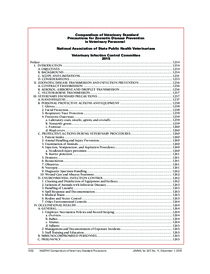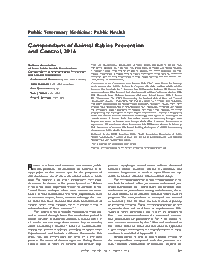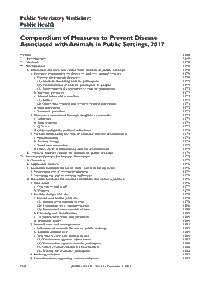Guides
 Model Infection Control Plan
Zoonotic Diseases - Guide
December 8, 2017
Model Infection Control Plan
Zoonotic Diseases - Guide
December 8, 2017
This plan should be adapted to your practice in keeping with local, state, and federal regulations. Please refer to the full Compendium of Veterinary Standard Precautions for complete information and guidance.
 Veterinary Precautions Compendium
Zoonotic Diseases - Guide
December 8, 2017
Veterinary Precautions Compendium
Zoonotic Diseases - Guide
December 8, 2017
The objectives of the Compendium are to raise awareness of the scope of zoonotic disease risk in veterinary medicine; address infection control issues specific to veterinary practice; provide practical, science-based veterinary infection control guidance; and provide a model infection control plan for use in individual veterinary facilities.
 Animal Rabies Compendium
Zoonotic Diseases - Guide
December 8, 2017
Animal Rabies Compendium
Zoonotic Diseases - Guide
December 8, 2017
Rabies is a fatal viral zoonosis and a serious public health problem. All mammals are believed to be susceptible to the disease, and for purposes of this document, use of the term “animal” refers to mammals. The disease is an acute, progressive encephalitis caused by a lyssavirus.
 Animals in Public Settings Compendium
Zoonotic Diseases - Guide
December 8, 2017
Animals in Public Settings Compendium
Zoonotic Diseases - Guide
December 8, 2017
This compendium provides standardized recommendations for public health officials, veterinarians, animal venue operators, animal exhibitors, visitors to animal venues and exhibits, and others concerned with control of disease and with minimizing health risks associated with animal contact in public settings.
 Rodent Exclusion Manual
Zoonotic Diseases - Guide
March 21, 2017
Rodent Exclusion Manual
Zoonotic Diseases - Guide
March 21, 2017
Controlling rodents in buildings is very important from the perspectives of both their potential effects on human health and their possible damage to physical structures. Rodent control can be an attainable goal, but it always demands more than randomly setting out a few traps.


